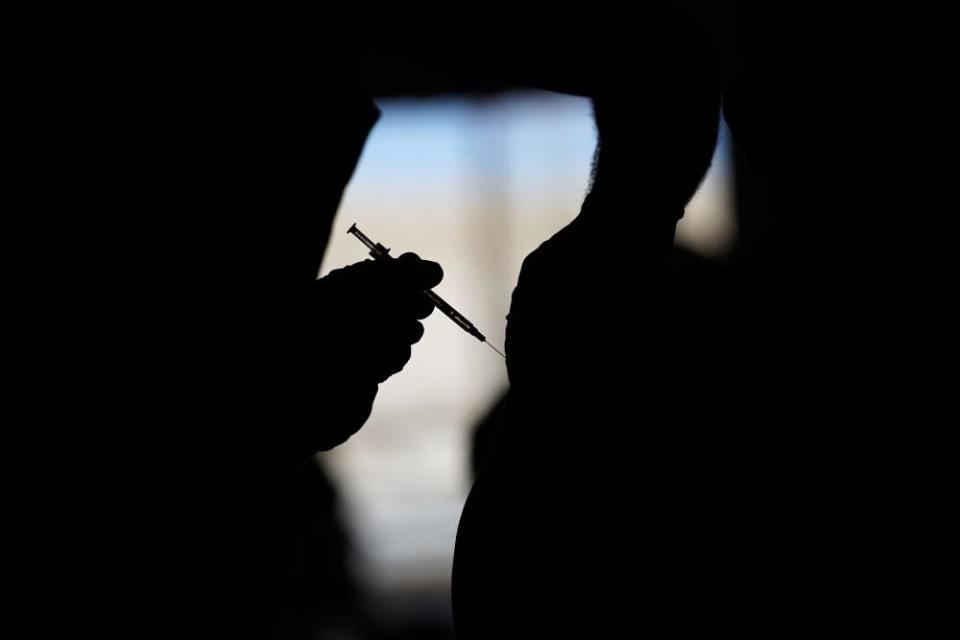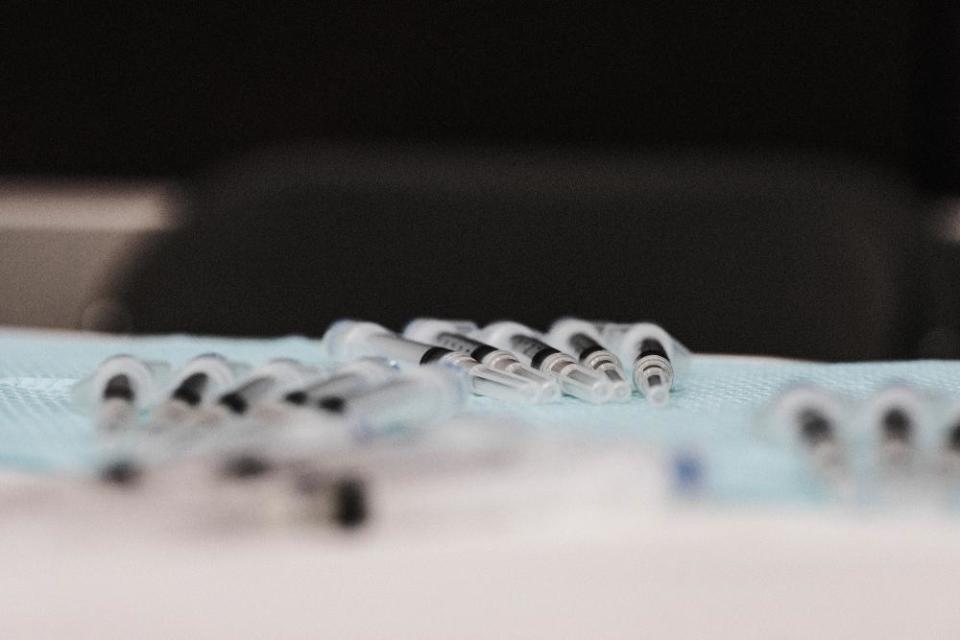Fear that Johnson & Johnson pause could heighten vaccine hesitancy in US

Teton county, Wyoming, is at the vanguard of America’s Covid-19 vaccination campaign – but it isn’t celebrating.
The county has vaccinated far more people proportionally than in most of America – 39% – compared to less than a quarter nationally. Local authorities are concerned they may have hit a saturation point. Vast, rural and conservative Wyoming is one of the most vaccine hesitant places in the nation, and fewer people are signing up for vaccine clinics. Similar patterns are emerging across the US.
Local authorities now worry the rare potential side effects of the Johnson & Johnson vaccine – so infrequent a person is twice as likely to be struck by lightning – could confirm the worries of some already hesitant to get vaccinated.
“There was so much interest, we got through all the priority populations, we opened to the general public and then it just went flat,” said Jodie Pond, Teton county health department director. There is still interest, she said, “but definitely less”.
A similarly deflating pattern is emerging in Malheur county, Oregon.
“We were really hoping we would have herd immunity by the middle or end of summer, and that’s just unlikely now,” said Sarah Poe, director of Malheur county health department. “This is going to be ongoing for at least the next year – which nobody wanted to hear.”
In both instances, experts said, these counties are a potential vision of the future of America’s vaccination campaign – one which will quickly move from shortage to surplus at a time when the Johnson & Johnson vaccine may prove especially useful in reaching the most marginalized, conservative and vaccine hesitant.
Similar scenes are playing out in Mississippi, where the state struggled last week to fill 73,000 vaccine slots. In Davison county, South Dakota, pharmacy director Eric Larson asked authorities if it was, “too late to ask not to send more vaccines”, because not enough people were signing up for vaccination slots, according to local newspaper the Mitchell Republican.

This week, Malheur has a mobile vaccine unit hoping to distribute 2,000 vaccine doses. “We would be a tremendous success if we used 1,000 of them,” said Poe.
For many in public health, these experiences are part of an unsettling sense that what America just went through – the clamor for appointments, rush to get vaccinated and the logistical difficulties of shortage – was the easy part. Now, experts such as Dr Marcus Plescia believe vaccination rates will slow not because of lack of supply, but because of lack of demand.
“We’re going to get to a point where we start to saturate that group that’s been pretty motivated, and we’re going to need to bring out some new strategies,” said Plescia, chief medical officer at the Association of State and Territorial Health Officials.
Many people are dead set against vaccination – they are simply unsure.
“When people are a little hesitant and they want to come talk to somebody about [the vaccine], that takes more time than someone who is dead set on it,” Plescia said.
Among authorities in rural, conservative and vaccine-hesitant states, the hope is the Johnson & Johnson pause will be as brief as possible, while also allowing for a thorough investigation and communication of findings.
We’re going to get to a point where we start to saturate that group that’s been pretty motivated, and we’re going to need to bring out some new strategies
Dr Marcus Plescia
The White House has argued the pause will not substantially impact national vaccine distribution rate because it represented the minority of doses. Nevertheless, the impact could be marked for the health departments and people who hope to rely on this specific vaccine.
“We had people actually leave the clinic hoping they would get [the Johnson & Johnson vaccine] elsewhere,” said Poe. She worries the so-called pause, “was validating to people who said, ‘Nope, they’re finding stuff now.’”
The US will likely move to resume Johnson & Johnson’s Covid-19 vaccine this coming week, possibly with restrictions or broader warnings after reports of some very rare blood clot cases, the government’s top infectious diseases expert said Sunday.
Dr Anthony Fauci said he expects a decision when advisers to the Centers for Disease Control and Prevention (CDC) meet Friday to discuss the pause in J&J’s single-dose vaccine.
“I would be very surprised if we don’t have a resumption in some form by Friday,” he said.
There are three vaccines authorized for emergency use in the US. Vaccines from Moderna and Pfizer use messenger RNA technology, while Johnson & Johnson’s uses viral vector. This week, scientists recommended Johnson & Johnson vaccinations be temporarily halted while they investigate six cases of rare blood clots among more than 7.7 million people that have received the shot.
The vaccine made by Johnson & Johnson subsidiary Janssen is the most recently authorized vaccine. Initially, public health officials were concerned people would need convincing to use this latest vaccine. Janssen’s trial results, while not comparable to those from Moderna and Pfizer, at first glance appear to show a lower efficacy rate. All vaccines are highly effective at preventing Covid-19 hospitalization and death.
But to the surprise of many, people asked for the Johnson & Johnson vaccine by name. People concerned about safety saw it as more traditional technology. And, unlike Moderna and Pfizer’s vaccines, it was also one-and-done, and has a less onerous profile for common flu-like side effects.
For people who worried about the novelty of mRNA vaccines, who would have trouble getting a day off work to get vaccinated or recover, Johnson & Johnson’s vaccine held significant advantages.

While the impact of the pause remains unclear, it comes in an environment of already reduced demand. In Teton, Pond recently had to cancel a 500-shot clinic when only 80 people signed up. All 80 were easily accommodated on another clinic day, a disquieting rather than reassuring sign. On other days, as many as 50 people have not shown up for shots.
A recent survey published by the Centers for Disease Control and Prevention (CDC) found an estimated 29% of Teton county residents are hesitant to get vaccinated. By comparison, liberal Massachusetts, Vermont and California are among the least vaccine hesitant places in the nation. There, just 6-9% of residents are hesitant to get vaccinated.
Recent surveys have shown Republican men and rural residents are among the most vaccine hesitant in the nation. Vaccine hesitancy is also correlated with being protestant or Catholic. All of these groups are also disproportionately likely to support former president Donald Trump, who for a year was a major source of Covid-19 misinformation, though the direct effect he had on people’s attitudes is unclear.
An estimated 18% of Malheur county are hesitant to get vaccinated. There, the county’s vaccine distribution has been walk-in since the beginning, because so many people in the area lack internet.
“We never had thousands of people in line,” said Poe. “There were times people had to show up and wait, but that honestly dissipated quickly once we were past the seniors.”
Only a little more than half of seniors are vaccinated in Malheur. Now, the 50-person staff often go hours without patients at the county’s walk-in vaccine clinic.
“I don’t know that people understand what it’s like to live in a community that’s 23% poverty, 10% undocumented and 10% of our kids are living in poverty, and not much public transportation,” said Poe.
Logistically, Johnson & Johnson’s vaccine was expected to be extremely helpful in places like Malheur and Teton. The county’s 30,000 residents are spread across 10,000 square miles. This is bigger than nine US states.
Johnson & Johnson’s vaccine is significantly easier to transport, requiring only common refrigerator cold storage compared to the specialty dry ice suitcases required for Pfizer’s vaccine. That meant the county could easily bring the vaccine to the county jail, homeless shelters, residential drug treatment facilities and agricultural areas, such as the county’s onion processing plants.
The difficulty is there is so much misinformation including from so-called medical professionals, that have content especially on Facebook and online
Sarah Poe
Poe had hoped to soon roll out Johnson & Johnson’s vaccine to Walmart pharmacies, which see a large number of low-income customers. And nationally, the vaccine was a good candidate for emergency rooms, where a high proportion of low-income and marginalized people get medical care, and at family medical practices, who are among the most trusted members of society.
Those changes would have also moved vaccination to settings hesitant people are more comfortable with, and away from government-run clinics. A study by University of Wyoming economists found in that state, distrust of the Biden administration and the Food and Drug Administration were major reasons people cited for waiting to get vaccinated.
Johnson & Johnson’s vaccine pause has also presented a messaging challenge. Many public health officials believe finding this faintest of safety signals – blood clots in less than one in a million people – is a triumph of vaccine safety monitoring. But blood clots are nevertheless frightening, even if exceedingly rare.
The same public safety database that detected the potential side effect, called the vaccine adverse events reporting system (Vaers), has also been appropriated by some to sow confusion. Online, anti-vaccine conspiracy theorists and conservative commentators have used anecdotal, unconfirmed reports from Vaers to argue vaccines are unsafe.
“The difficulty is there is so much misinformation including from so-called medical professionals, that have content especially on Facebook and online, and it gets a lot of attention,” said Poe.
“I am so disappointed in people who are doing harm, discouraging use of the vaccine, because people will lose their lives when people don’t get the vaccine”.
In the same communities, stakes could not be higher.
Teton is home to two of America’s most iconic tourist destinations – Yellowstone and Grand Teton national parks. With nearly a million visitors expected this summer, the vaccination campaign is a race against the clock to protect people.
“We’re going to have people descend on us like they did last summer,” said Pond. “We want to get people who live and work here before all the tourists come in and hopefully protect ourselves,” she said. “We can’t say – ‘Only people who are vaccinated come to Teton county’ – we’re going to get everybody.”
Meanwhile, in Malheur, cases are rising. Fifty-eight people in the county have died from Covid-19 and at least 3,400 sickened.
“We’re still in a pandemic, our cases are rising around us, this is exactly what we needed and it is working,” said Poe. “Every time we hear of these severe cases, and outbreaks and deaths of a vulnerable person – honestly it’s so heartbreaking – because that was a life we could have saved”.

 Yahoo Movies
Yahoo Movies 